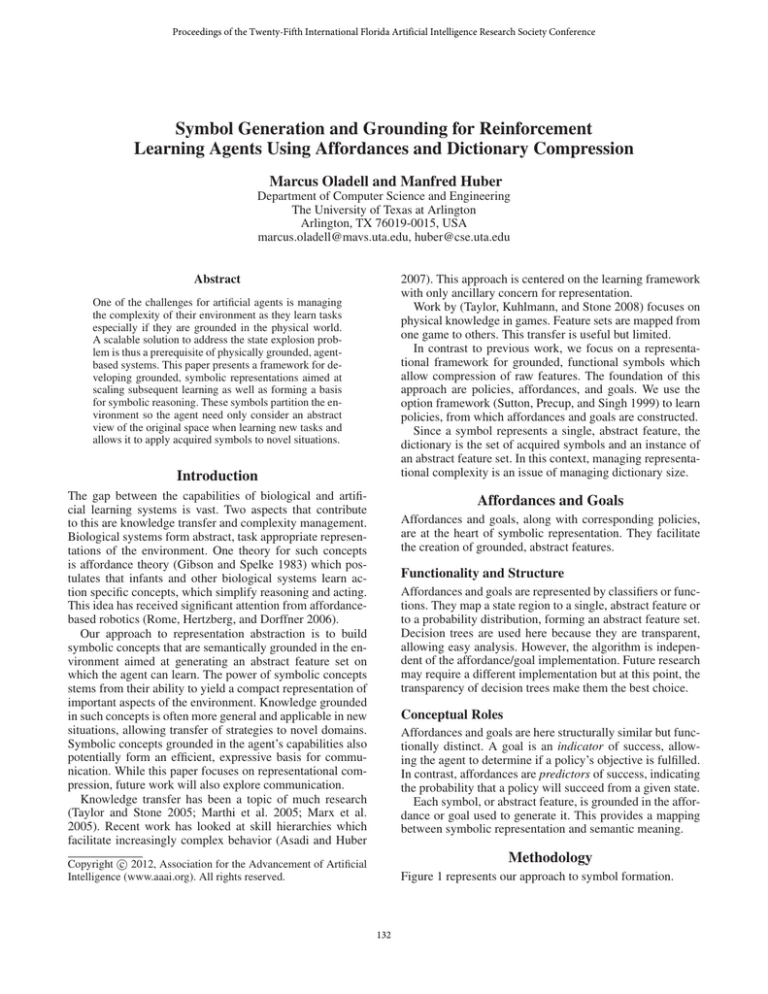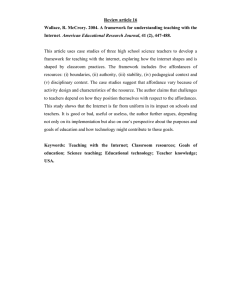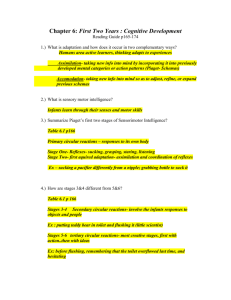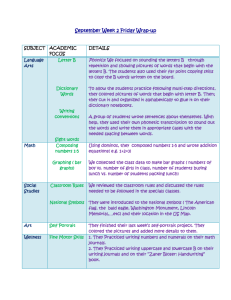
Proceedings of the Twenty-Fifth International Florida Artificial Intelligence Research Society Conference
Symbol Generation and Grounding for Reinforcement
Learning Agents Using Affordances and Dictionary Compression
Marcus Oladell and Manfred Huber
Department of Computer Science and Engineering
The University of Texas at Arlington
Arlington, TX 76019-0015, USA
marcus.oladell@mavs.uta.edu, huber@cse.uta.edu
Abstract
2007). This approach is centered on the learning framework
with only ancillary concern for representation.
Work by (Taylor, Kuhlmann, and Stone 2008) focuses on
physical knowledge in games. Feature sets are mapped from
one game to others. This transfer is useful but limited.
In contrast to previous work, we focus on a representational framework for grounded, functional symbols which
allow compression of raw features. The foundation of this
approach are policies, affordances, and goals. We use the
option framework (Sutton, Precup, and Singh 1999) to learn
policies, from which affordances and goals are constructed.
Since a symbol represents a single, abstract feature, the
dictionary is the set of acquired symbols and an instance of
an abstract feature set. In this context, managing representational complexity is an issue of managing dictionary size.
One of the challenges for artificial agents is managing
the complexity of their environment as they learn tasks
especially if they are grounded in the physical world.
A scalable solution to address the state explosion problem is thus a prerequisite of physically grounded, agentbased systems. This paper presents a framework for developing grounded, symbolic representations aimed at
scaling subsequent learning as well as forming a basis
for symbolic reasoning. These symbols partition the environment so the agent need only consider an abstract
view of the original space when learning new tasks and
allows it to apply acquired symbols to novel situations.
Introduction
The gap between the capabilities of biological and artificial learning systems is vast. Two aspects that contribute
to this are knowledge transfer and complexity management.
Biological systems form abstract, task appropriate representations of the environment. One theory for such concepts
is affordance theory (Gibson and Spelke 1983) which postulates that infants and other biological systems learn action specific concepts, which simplify reasoning and acting.
This idea has received significant attention from affordancebased robotics (Rome, Hertzberg, and Dorffner 2006).
Our approach to representation abstraction is to build
symbolic concepts that are semantically grounded in the environment aimed at generating an abstract feature set on
which the agent can learn. The power of symbolic concepts
stems from their ability to yield a compact representation of
important aspects of the environment. Knowledge grounded
in such concepts is often more general and applicable in new
situations, allowing transfer of strategies to novel domains.
Symbolic concepts grounded in the agent’s capabilities also
potentially form an efficient, expressive basis for communication. While this paper focuses on representational compression, future work will also explore communication.
Knowledge transfer has been a topic of much research
(Taylor and Stone 2005; Marthi et al. 2005; Marx et al.
2005). Recent work has looked at skill hierarchies which
facilitate increasingly complex behavior (Asadi and Huber
Affordances and Goals
Affordances and goals, along with corresponding policies,
are at the heart of symbolic representation. They facilitate
the creation of grounded, abstract features.
Functionality and Structure
Affordances and goals are represented by classifiers or functions. They map a state region to a single, abstract feature or
to a probability distribution, forming an abstract feature set.
Decision trees are used here because they are transparent,
allowing easy analysis. However, the algorithm is independent of the affordance/goal implementation. Future research
may require a different implementation but at this point, the
transparency of decision trees make them the best choice.
Conceptual Roles
Affordances and goals are here structurally similar but functionally distinct. A goal is an indicator of success, allowing the agent to determine if a policy’s objective is fulfilled.
In contrast, affordances are predictors of success, indicating
the probability that a policy will succeed from a given state.
Each symbol, or abstract feature, is grounded in the affordance or goal used to generate it. This provides a mapping
between symbolic representation and semantic meaning.
Methodology
c 2012, Association for the Advancement of Artificial
Copyright Intelligence (www.aaai.org). All rights reserved.
Figure 1 represents our approach to symbol formation.
132
Raw
Features
Goal and Affordance Construction
State
Representation
For each policy, a goal and affordance are built as decision
trees. A goal of policy π indicates the likelihood that a state
meets the goal criteria of the policy:
X
P r(st = sg |si , π)
gπ : si →
Policy
Construction
sg ∈Sg
Policy
where P r(s0 |s, π) indicates the probability that policy π
initiated in state s terminates in state s0 .
Discovering goal states is non-trivial (Digney 1996; McGovern and Barto 2001). For this paper we assume Sg is
known. Given this, goal classifier training data is generated
by executing a policy, π, and labeling the resulting terminal
states, st , according to their membership in Sg . Once a goal
is constructed, an affordance is built which provides a mapping from the feature set to the probability of policy success.
X
P r(sg |si , π)
Aπ : si → R , si →
Goal
Construction
Goal
Affordance
Construction
Affordance
Dictionary
Sub-Structure
Extraction
sg ∈Sg
Symbolic
Features
Once constructed, affordances and goals act as symbols,
representing abstract state features. The symbolic feature set
allows the agent to reason without considering the raw features and forms the foundation of the agent’s vocabulary.
The result of an affordance or goal can be discrete or continuous. Our current implementation constructs affordances
and goals as discrete classifiers. However, symbol learning
can also use continuous features (Papudesi and Huber 2006),
and future work will include continuous symbols.
Figure 1: Symbol Generation. Processes are represented as
ovals, while data are represented as boxes
Policies are constructed on the current state representation
which initially consists of raw features. Once built, it is used
as input to the goal and affordance construction processes.
A policy goal is constructed first before a corresponding affordance. Each affordance and goal results in the creation of
a new symbol which is appended to the agent’s dictionary.
A separate process examines the dictionary for common
sub-structures. Extracting such structures and creating corresponding symbols results in dictionary compression. Also,
the new symbols are not bound to a policy but represent environment features which, together with affordance and goal
symbols, generate new, abstract state representations.
Structure Extraction and Dictionary Compression
There is a correlation between dictionary size and complexity of the feature set. Our approach is to find common substructures that occur multiple times within the dictionary.
Representing symbols as decision trees imposes restrictions on potential sub-structures. First, any sub-structure
node must maintain its edges since we can not ignore potential outcomes. Second, only non-leaf nodes are included
to facilitate use as a parameter. Categories in leaf nodes become edge labels, leaving the construct intact and allowing
leaf nodes to be appended for use as an independent symbol.
There are many sub-structure identification approaches
(Holder, Cook, and Djoko 1994; Kuramochi and Karypis
2001). Given the small size of affordances and goals in
this paper, we use a brute force method. However, future
work will integrate a more efficient algorithm. The proposed
framework is indifferent to the method, provided the resulting structure meets the requirements. Once a sub-structure
has been found, its impact on dictionary size is evaluated.
Using decision trees, a symbol, Φ, is formulated in graph
notation. The size of a vertex, vΦ , and an edge, eΦ , are fixed:
Underlying Policy and System Model
The initial set of policies are constructed on the raw feature space using Q-Learning on an MDP. Different tasks are
here learned by changing the reward function, R. Once initial policies are learned, these are leveraged as potential decisions (options) using the formulation of SMDPs (Sutton,
Precup, and Singh 1999) where the state is represented by a
set of N features, each representing a variable that can take
on n values. Together they form the state space, S. This flexible definition can accommodate raw and abstract features.
S = " Fi , Fi ∈ {f1i , f2i , ..., fni }
i
Policy Construction
GΦ = (VΦ , EΦ ) , NVΦ = size(vΦ ) , NEΦ = size(eΦ )
Once a new task is presented, a goal-based option is learned
on the current representation. Here, the option, Oπ , is a policy, π, which defines a mapping from states to actions, the
initialization states, SI , where the policy can be initiated, the
termination states, ST , which signal the end of policy execution and the goal states, Sg , which is a subset of ST .
Oπ = hπ, SI , ST , Sg i , Sg ⊂ ST
Using this, we can calculate the size of each symbol, Φ
and, by extension, the size of a dictionary, D.
size(Φ) = NVΦ ∗ |VΦ | + NEΦ ∗ |EΦ |
X
size(D) =
size(Φ)
Φ∈D
133
Linguistic Aspects of Symbolic Representations Affordances, goals and policies represent potential means of
symbol grounding where new symbols generated via substructure extraction are grounded in raw features. Policies
here are action phrases. Affordances and goals are similar to
noun phrases with an implicit subject. Given a dictionary as
described above, we can construct a sentence that takes the
form of an if-then statement: Aπ ∧ π → gπ .
Parameterization yields shorter sentences as the sentence
is constructed using symbolic rather than raw features.
With the dictionary size we can calculate the impact of
a sub-structure. D’ is the dictionary after extraction of substructure Φss . The number of occurrences of Φss is NΦss .
size(D0 ) = size(D) − size(Φss ) ∗ (NΦss − 1)
The greater the difference between the size of D and D’,
the better the compression impact of Φss .
Gripper Robot Example This example shows a simple
instance of sub-structure extraction. Our agent is a robot arm
with a camera. The environment contains dice which vary in
size and color and always have one side facing up.
Number
<= 1 > 1
Color
Color
red !red
red !red
size
-
Size
<= 10 > 10
+
6Disposable(N, ”Light”) ∧ Dispose6 → 6Disposed
As shown in Figure 2, the uncompressed version of 6Disposable requires three features. After compression, as shown
in Figure 3, 6Disposable requires only two parameters.
Shorter sentences improve reasoning as it implies less
complexity. Moreover, it has potential benefits for communication as the number of bits required for transfer is reduced.
Number
<= 5 > 5
-
6Disposable(N, C, S) ∧ Dispose6 → 6Disposed
-
-
Implementation
<= 10 > 10
-
+
The approach is demonstrated in a simulation environment
with a robot arm and camera. Learning tasks revolve around
lift, move, and drop and the SMDP framework (Sutton, Precup, and Singh 1999) is used to build policies using QLearning. Policies can then be used in higher level tasks.
As the agent learns new policies, affordances and goals
are generated and added to the dictionary. After each addition, the best common sub-structure is extracted, compressing the dictionary and generating a new, abstract feature.
-
(a)
(b)
Figure 2: Affordances for Dispose Policies. (a) 6Disposable
(Number, Color, Size), (b) 1Disposable(Number, Color, Size)
The agent knows two policies, Dispose6 and Dispose1,
with affordances shown in Figure 2. There is a hidden correlation between size and color and the agent’s ability to lift it.
If size is no more than 10 and color is red, the die is ”light”.
The underlying correlation is encoded in the affordance.
Number
Color
red
Table 1 shows the raw feature set. Although the environment
has an arbitrary number of objects, agent perception is limited to three. This limitation will be lifted in future work.
Number
<= 5 > 5
Size
Raw Feature Set
<= 1 > 1
!red
<= 10
Light
-
> 10
"+"
"-"
1
0
(a)
Light
+
+
(b)
-
+
+
(c)
Figure 3: Dictionary Following Sub-Structure Extraction.
(a) ”Light”, (b) Disposable6(Number, ”Light”), (c) Disposable1(Number, ”Light”)
Attribute
hue
type
stack
weight
at
Description
object color
visual categorization
object top of stack?
object liftable?
agent currently at object?
Visual?
yes
yes
yes
no
yes
Attribute
selected
held
finished
Description
which object is currently selected?
which object is currently held?
has the agent finished?
Table 1: Object Features (Top), Global Features (bottom)
The dictionary compression yields the symbols shown in
Figure 3. A sub-structure, labeled ”Light”, was extracted
and 6Disposable and 1Disposable became parameterized
symbols. The new symbol, ”Light”, has some noteworthy
properties. The output from ¬red and > 10 is combined as
they yield the same results. The original structure is maintained to facilitate use in a context where ¬red and > 10
differ. When used as an independent symbol, however, the
external results are compressed, resulting in a binary feature.
While the symbol here is binary, this is not a restriction
and symbols, in general, can be discrete or continuous.
Primitive Actions and Policy Construction
Table 2 lists the agent’s primitive actions from which we
constructed three policy classes: lift, stack, and clean.
Within each policy class, we learn three policies: one general instance targeting the first lift-able object, one targeting
a red object, and one targeting objects of type 1.
For each policy, affordance and goal classifiers are built.
Goal states are assumed to be known.
134
Action
find
select
goto
pickup
drop
finish
Description
Reveals the next visible object
Selects the next visible object
Move to selected object
Pickup the object at the current location
Drop the currently held object
Terminate learning task
Table 4 shows significantly improved results with this approach. This indicates that parameterized sub-structures can
yield improved compression and symbolic features.
D
D’
Φss
Table 2: Primitive Actions
Bytes
221296
170374
944
Nodes + Edges
2506
1696
16
Table 4: Compression for Generalized Object (NΦss = 54)
Training data for an affordance is generated using the policy and goal classifier by sampling terminal states of policy
executions from random starting points, resulting in a mapping from state to the probability of successful execution.
The implementation limits affordances to three classes, yes,
no and maybe, the last representing nondeterministic outcomes. Future work will use a more detailed representation.
Conclusion
As the complexity of learning tasks increase, the size of
the representational space grows. This paper proposes an
approach to managing representational complexity using a
symbolic feature representation generated via policies, affordances and goals. Affordances and goals ground the symbols that constitute the agents dictionary and generate an abstract feature set for subsequent learning. Dictionary size is
managed through sub-structure extraction, which removes
redundancy. Extracted symbols form new abstract features.
Dictionary Compression Results
We compressed the dictionary as shown in Table 3.
D
D’
Φss
Bytes
221296
194707
8864
Nodes + Edges
2506
2089
140
References
Asadi, M., Huber, M. 2007. Effective control knowledge transfer through learning skill and representation hierarchies. Proc. IJCAI, 2054–2059.
Digney, B. 1996. Emergent hierarchical control structures:
Learning reactive / hierarchical relationships in reinforcement environments. Proc. SAB.
Gibson, E., Spelke, E. 1983. The Development of Perception. Wiley.
Holder, L.B., Cook, D.J., Djoko, S. 1994. Substructure Discovery in the SUBDUE System. Proc. AAAI Workshop on
Knowledge Discovery in Databases.
Kuramochi, M., Karypis, G. 2001. Frequent subgraph discovery. Proc. ICDM, 313-320.
Marthi, B., Russell, S., Latham, D., Guestrin, C. 2005. Concurrent hierarchical reinforcement learning. Proc. AAAI,
Marx, Z., Rosenstein, M., Kaelbling, L., Dietterich, T. 2005.
Transfer learning with an ensemble of background tasks.
NIPS 2005 Workshop on Transfer Learning.
McGovern, A., Barto, A. 2001. Automatic Discovery of
Subgoals in Reinforcement Learning using Diverse Density.
Proc. ICML, 361–368.
Papudesi, V., Huber M. 2006. Learning Behaviorally
Grounded State Representations for Reinforcement Learning Agents. Proc. EpiRob.
Rome, E., Hertzberg, J., Dorffner, G. 2006. Towards
Affordance-Based Robot Control. Springer.
Sutton, R.S., Precup, D., Singh, S. 1999. Between MDPs
and semi-MDPs: A framework for temporal abstraction in
reinforcement learning. Artificial Intelligence 112(1-2):181.
Taylor, M.E., Stone, P. 2005. Behavior transfer for valuefunction-based reinforcement learning. Proc. AAMAS, 53.
Taylor, M., Kuhlmann, G., Stone, P. 2008. Autonomous
transfer for reinforcement learning. Proc. AAMAS, 283–290.
Table 3: Compression Results (NΦss = 3)
Symbol extraction yielded a reduction of 12% in dictionary size and 16% in node/edge count. Extracted symbols
were typically around 100 elements.
Most Frequent Sub-Structure In addition to dictionary
compression, we also looked at sub-structures in the context
of object generalization. Figure 4 shows two very similar
structures. Sub-structure detection treats them as different
due to the difference in object id. To address this, we altered
the algorithm to treat all object ids as being the same object.
Object1
feature hue
red
Object1
type-2
type-1
feature type
type-0
blue
Object1
0
type-0
feature type
ype-1 type-2
feature hue
red
type-1
Object1
+
Object2
type-2
feature type
type-1 type-2 type-0
-
Object2
green
feature type
type-0
blue
Object2
green
feature type
type-1 type-2 type-0
Object2
type-0
feature type
ype-1 ype-2
+
Figure 4: ”Light” for Object 1 (top) and Object 2 (bottom)
135









